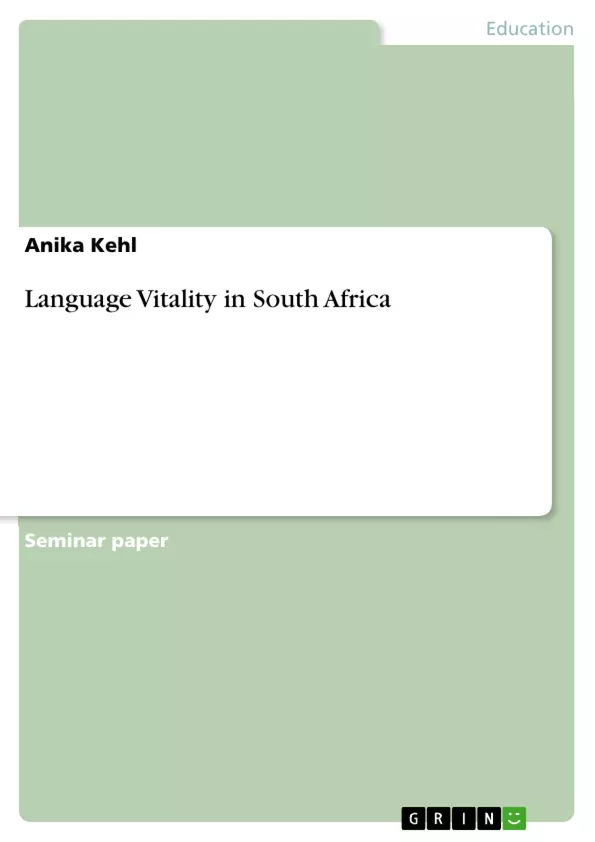There are 24 languages which are regularly used by more than 44.8 million South Africans and almost 80 % of the South African population use one of the African languages at home. “The most commonly spoken home language is isiZulu, which is spoken by 23.8 % of the population, followed by isiXhosa (17.6 %) and Afrikaans (13.3 %)” Although English is the home language of only 8.2 % of the South African population it is still used as a lingua franca throughout the nation. The eleven official languages are used by 99% of the country’s population and those languages are all supposed to have equal rights. Belonging to these languages are English and Afrikaans, and nine other African languages: “Sepedi, Sesotho, Setswana, siSwati, Tshivenda, Xitsonga, isiNdebele, isiXhosa, and isiZulu”. There are also many other languages spoken in South Africa like for example Arabic, German, Greek, Hindi, Tamil, Hebrew and many more. Some European languages like French, German, and Portuguese are used in South Africa but they are not nearly as influential as English.
The historical development of South Africa has brought the question of language forward. The country became aware of its unique language situation and the chances and problems which are connected to it. After Mandela many people developed a greater interest in smaller languages. The paper is going to explore the language vitality of some of the 11 official South African languages, dealing with the problem of language endangerment/death and language reviltalisation. It is going to be seen whether the multilingualism which is propagandized by the government is or can be realised in real life. Due to the lack of valid information for many of the smaller indigenous Afrcian langugeas the paper will mostly look at the situation of Afrikaans and English, only rarely concidering the other languages in much detail.
Inhaltsverzeichnis (Table of Contents)
- Introduction
- Language Vitality
- Different attitudes
- Language policy - Official attitudes towards the 11 official languages
- Personal attitudes towards the languages
- Absolute number of speakers
- Proportion of speakers within the total population
- Trends in existing domains
- Current situation in South African language domains
- Example of an army camp
- Response to new domains and media
- Language in Education
- Intergenerational Language Transmission
- Categorising South Africa's official languages
- Southern Khoisan in South Africa – An Example of language death and its aftermath
- How to use the nine factors of language vitality
- Different attitudes
- A project
Zielsetzung und Themenschwerpunkte (Objectives and Key Themes)
This paper examines the language vitality of several official South African languages, focusing on the challenges of language endangerment and death and the possibilities for revitalization. It explores whether the government's promotion of multilingualism is a reality or an ideal.
- The dynamics of language vitality in South Africa.
- The impact of language policy on language use and attitudes.
- The role of intergenerational language transmission in language survival.
- The challenge of language endangerment and death in South Africa.
- The potential for language revitalization and maintenance.
Zusammenfassung der Kapitel (Chapter Summaries)
- The introduction establishes the context of language endangerment and death globally and specifically highlights the unique linguistic situation in South Africa. It explores the importance of language diversity for cultural identity and discusses the challenges of preserving minority languages.
- Chapter 2 defines and discusses the concept of language vitality, analyzing the different factors that contribute to a language's health and survival. It examines official language policies and the attitudes of the population towards different languages, including the use of English as a lingua franca.
- The chapter delves deeper into the language vitality framework, exploring factors such as the absolute number of speakers, the proportion of speakers within the population, trends in language use in different domains, and the role of intergenerational language transmission.
- This chapter focuses on the specific case of Southern Khoisan languages in South Africa, showcasing how language death and its consequences have impacted the cultural identity of the indigenous population.
- The final chapter of this section outlines a practical approach to applying the nine factors of language vitality to assess the status of languages in South Africa.
Schlüsselwörter (Keywords)
This paper focuses on language vitality, language endangerment, language death, language revitalization, multilingualism, South Africa, official languages, language policy, intergenerational language transmission, indigenous languages, Afrikaans, English.
- Quote paper
- Anika Kehl (Author), 2011, Language Vitality in South Africa, Munich, GRIN Verlag, https://www.grin.com/document/279063



